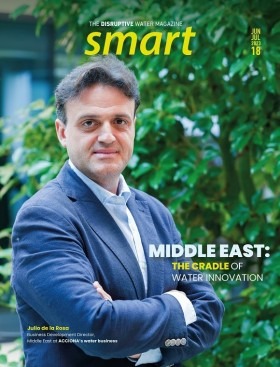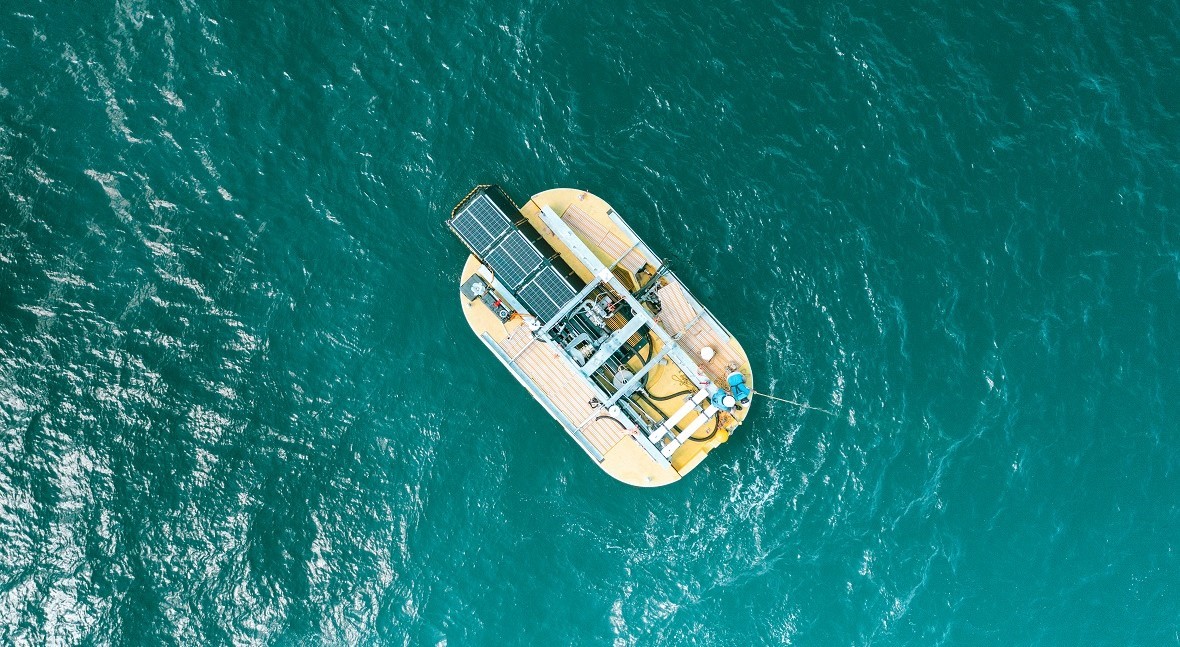“Our goal is to approach the global market with our scaled desalination solutions at a lower cost”

Combining the ocean’s seawater with its own wave energy, the desalination buoy systems by Oneka Technologies can provide competitively priced water to coastal communities and industries without compromising the environment.
Innovation plays a crucial role in developing sustainable and efficient solutions to address water scarcity, harnessing the power of technology and creative thinking. Proof of this is the wave-powered desalination buoys developed by Oneka Technologies, aiming to become the most affordable solution on the market with no GHG emissions. Dragan Tutic, CEO & co-founder of Oneka Technologies, answered our questions on the technology and business model they use, and the company’s plans for further development and deployment of their desalination systems.
Please tell us briefly about your career path and your current role at Oneka Technologies.
CEO and co-founder of Oneka Technologies, I am an entrepreneur and mechanical engineer from Sherbrooke, Canada. Since I was young, I have always been involved in business and engineering projects. As I become more and more concerned about climate change and the resulting disasters, I wanted to dedicate my life to addressing it through the power of engineering and entrepreneurship. While I was initially involved in mobility and electric vehicles, an already crowded market, I decided to shift my focus to freshwater access after spending a few years traveling. The need for sustainable and affordable desalinated water is desperately growing, which I believe represents an opportunity with a better chance of success. To achieve this, I’m privileged to have surrounded myself with a savvy multi-disciplinary team, veterans of various industries including desalination and offshore marine, and a network of reputable business and financial partners. By successfully leading several rounds of financing and achieving good technical and commercial results, we are leading the way in making the oceans a sustainable and accessible source of freshwater.
Oneka’s sustainable wave-powered desalination buoy systems offer a host of environmental benefits. How do they compare to land-based plants, and other floating desalination systems? What about in terms of the cost to produce drinking water?
When we analyse the competition, we are mainly comparing ourselves to conventional and solar desalination companies since wave-powered desalination companies are at a very early stage. As we demonstrated at the Waves to Water Prize and won the Grand Prize, Oneka has a clear lead over its competitors who also harness wave energy. The quality of the water, the production capacity and the ease of assembly and deployment of our systems set us apart.
Furthermore, our wave-powered desalination systems have been designed to operate in synergy with marine and terrestrial environments.
First, our solutions do not emit any GHG emissions. By using Oneka's off-grid and decentralized solution instead of conventional desalination, about 1 ton of CO2e is saved each year for each m3 of water produced daily. The installed systems are self-sufficient and do not require electricity or other energy sources to provide water to our clients.
Our solutions do not emit any GHG emissions; they are self-sufficient and do not require other energy sources to provide water
Second, compared to conventional desalination plants that can discharge brine that is 100-150% saltier than seawater, Oneka produces brine that is only 30% saltier. Because the intakes and outfalls of the various offshore units are located far away from each other, the brine is also discharged naturally over a wide area, and the action of waves and ocean currents accelerates the mixing. In conventional desalination plants, brine is normally discharged at a specific point along the coast, requiring energy-intensive brine management.
Third, our modular systems that are deployed offshore limit the land footprint, which is a significant barrier for solar desalination projects in areas where coastal land is expensive or protected. Several metres offshore, the Oneka buoy array has little or no visual impact.
Utilizing the renewable energy in ocean waves, Oneka has a great deal of room to grow into the most affordable solution on the market
Fourth, based on observations, we noted that the seabed anchor could potentially be used in a positive way for the ocean by optimizing the design of it based on the specific needs of the site (diversity of marine life, hard bottom, corals, etc.). Further studies will be conducted to confirm the potential positive impact on marine ecosystems.
Finally, the cost of energy can represent up to 50% of the cost of water. By utilizing the renewable and unlimited energy contained in the ocean waves, Oneka has a great deal of room to grow into the most affordable solution on the market once Oneka scales its systems and begins mass production. Offering water as a service, the cost of water depends on many factors specific to the installation site. Oneka is already able to provide competitively priced water in many parts of the world.
What technologies are used in wave-powered desalination buoy systems?
Our wave-powered desalination system eliminates the energy conversion steps usually found in conventional desalination systems. Our 100% mechanical technology includes various filtration steps to get clean and drinkable water. The seawater goes through a strainer, pre-filters and reverse osmosis membranes before becoming freshwater. In order to pressurize the seawater, which is necessary in the desalination process, the water is pumped using a hydraulic pump that uses the oscillating motion of the ocean waves as the sole source of energy.
How does your Water-as-a-Service solution work?
Oneka Technologies provides a solution for clients who are looking to obtain a water supply solution with minimal financial risks. Unlike a traditional Equipment Purchase where the client has to take on all the risks of finance, permitting and compliance, insurance, procurement, construction, operation and maintenance, Oneka Technologies finances, designs, installs, maintains and operates their systems at its own cost. The Oneka team also monitors the system performance and the water quality according to local standards. Under this business model known as “Build-Own-Operate” (BOO), the client simply pays for the water on a volumetric (per cubic metres, gallons) basis.
There are many potential benefits from scaling up Oneka's technology in Chile, both for communities and for productive sectors
This model transforms the typical vendor-customer relationship into a partnering relationship where the interests of both the client and Oneka are aligned. As opposed to equipment manufacturers who must make their money upfront, Oneka must design solutions that perform over the life of the contract. Since Oneka’s capital is at risk and is paid only when we deliver water, our plants are designed with durability, reliability and energy efficiency in mind. That means our clients can focus on their core business while having the peace of mind of Oneka’s professional services and devoted team.
Oneka has a demonstration project in Chile and will be opening a subsidiary in this country. Can you comment on what these developments entail for the company?
Oneka's decision to open a subsidiary in Chile follows the successful demonstration of the technology in the ideal wave conditions of the Pacific Ocean and on Chile's long coastline, as well as many potential benefits from scaling up Oneka's technology in Chile, both for communities suffering from water scarcity and for productive sectors.
Discussions have been advancing thoroughly in recent months with, among others, mining companies, so the incorporation of Oneka in Chile was a necessary step in Oneka’s international growth strategy.
The Glacier system will produce up to 500 m3 of freshwater per day, allowing us to reach a broader market: municipalities and industries
Oneka sees a perfect fit between its sustainable desalination solutions, the Chilean market and the timing for deploying such solutions in the country. The mining industry has a goal of becoming net zero by 2040 and increasing the proportion of desalinated water in its water portfolio from 23% to 68% by 2032.
The Government of Chile, as mentioned by Mr Diego Pardow, Minister of Energy of Chile, last April during the inauguration of Oneka’s site, supports the deployment of renewable energy projects in the country. He wants to ensure the energy transition to ensure economic growth as well as social and justice prosperity. The country’s growing water scarcity problem is critical and Oneka can play an important role in addressing it.
Could you share the details of the development of the Glacier utility-scale units?
After developing the classes Icecube (1 m3 of water per day) and Iceberg (50 m3 of water per day), Oneka will scale up its wave-powered desalination solution to utility-scale, creating a Glacier system, a unit that will produce up to 500 m3 of fresh water per day. The scale of it will be to optimize the technology’s cost per volume produced.
We are now entering the acceleration phase of the business which includes the deployment of Iceberg buoys in our initial markets
Oneka Technologies will work with project partners AF Theriault who is supporting the manufacturing of the hull and structure of the Glaciers; H2O Innovation who is providing the process plant for the desalination portion of the Glacier technology; and a government partner, the City of Barrington, Nova Scotia who will provide a coastal site for buoy installation at Cape Sable Island. This class of buoys will allow us to reach an even broader market: large municipalities and industries, which is one step closer to achieving its mission of making the oceans a sustainable and affordable source of freshwater.
Can you tell us about your plans for deployments of wave-powered desalination buoy systems in the coming years?
Oneka Technologies currently has two demonstration sites, one in Florida and one in Chile. We are now entering the acceleration phase of the business which includes the deployment of Iceberg buoys in our initial markets, which are California, Chile and the Caribbean. At the same time, we are developing our utility-scale Glacier systems, which we will then have the opportunity to demonstrate in Nova Scotia with the City of Barrington as well as in Chile in partnership with a mining company that will provide water to coastal communities facing water scarcity. Our goal is to then be able to approach the global market with our scaled solutions that enable sustainable water desalination at a lower cost than other available desalination solutions.
What markets are you initially targeting?
To facilitate the deployment of our first wave-powered desalination units, these initial markets were identified by Oneka because of the following characteristics: communities and industries in the region are facing water scarcity and must adopt desalination solutions, the region's wave regime is ideal, water and energy costs are high, and going green is a priority. The three regions targeted by Oneka are the Caribbean, Chile and California. We offer water for small communities and industries as well as large municipalities and industries consuming large volumes of water, in addition to emergency relief applications with our Icecube-class units. While we receive inquiries from all over the globe, we find it important to focus on proper execution and expand from there worldwide.








